Safe Household Cleaning is reader-supported. All reviews are independent and any products reviewed are purchased by the site owner. To help fund this model, some of the links on the site are affiliate links. If you decide to make a purchase from one of these links, this site will receive some commission. At no cost to you. It helps keeps this place running. Learn more
| Earth Friendly Products ECOS Free and Clear Laundry Detergent | |
|---|---|
| Review Score |  |
| Ewg Rated | C |
| Ingredients | Water Sodium Coco-Sulfate Cocamidopropyl Betaine Lauryl Glucoside Potassium Cocoate Tetrasodium Glutamate Diacetate Phenoxyethanol Cocamidopropylamine Oxide Methylisothiazolinone |
ECOS Laundry Detergent isn't a one-size-fits-all green laundry solution. It'll produce great visual results with certain fabrics, but it won't impress your guests when they're presented with rough bath towels. With one or two tweaks, it could be a great detergent. They need to improve its washing ability as well as replace one or two preservatives to be truly considered a great product. But, if you want to take a small step towards achieving a greener lifestyle, feel free to road test it yourself. | |

Who doesn’t love the idea of an eco-friendly laundry detergent? I know I do. When I was initially presented with the chance to road test Ecos Laundry Detergent, I was delighted.
With a longstanding history of producing eco-friendly products (50 years, to be precise), ECOS specialize in producing everyday household solutions, with a green twist.
As a family-run business, they draw inspiration and opinions from those who are most likely to use what they put on the shelves.
Their design and manufacturing process also incorporates the expertise of chemists and ‘visionaries,’ just to ensure that what they make is both unique and safe. Operating from four carbon-neutral plants, they create products that aim to make green living affordable.
This is a company who inherently understand the issues with today’s cleaning industry, and are actively trying to do something about it.
First Impressions: ECOS Laundry Detergent Branding and Packaging
True to their eco-friendly nature, the ECOS team produce packaging that’s soft and serene. A gentle blend of blues and greens that melt into one another complement their earth-positive messages. Although the label on the front looks a little text-heavy, the manufacturers appear to compensate with their use of orange for the more pertinent details. For example, it’s clear that it includes fabric softener; thanks to the vibrant orange capitalized statement.
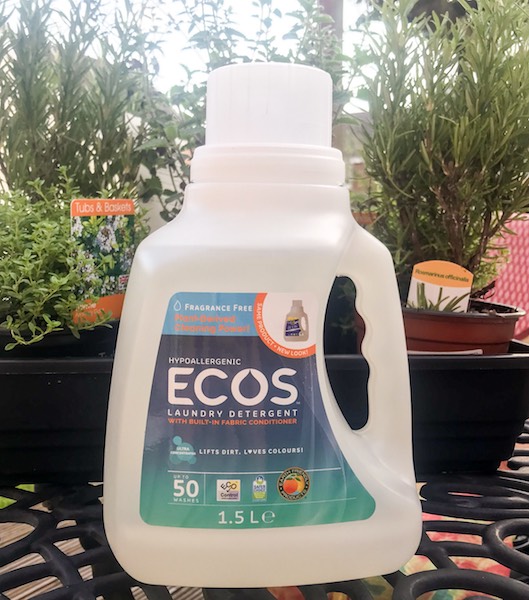
For the sake of reassurance, ECOS also embellish the front of the product with the various accolades it has earned. My only real complaint about said accolades is that one is so small, it’s virtually impossible to read. As someone who routinely produces perfect scores when faced with a Snellen chart, I can imagine those with poor eyesight more than struggle.
Turn to the back of the laundry detergent and the warm fuzzy nature of ECOS branding continues. You also benefit from a clear list of ingredients, which is refreshing in today’s market. Manufacturers don’t need to aim for accuracy on the ingredients front, which places us consumers at a disadvantage. ECOS, however, lays everything bare – warts and all – with even the less favorable ingredients on display.
Like all good detergents, it provides sufficient guidance on how much to use in accordance with your laundry load, staining, and water area. From my perspective, that hands over a fair amount of power to consumers, who deserve to know exactly how to use a product when they invest money in it.
What’s inside the bottle?
I’m the first to admit that I am a bit of a sucker for enticing smells when it comes to laundry detergents. If it results in my clothes smelling like lavender, it’s going to win me over.
The first impressions of ECOS is the smell. This is a fragrance-free product, which is preferable for sensitive skin sufferers. Fragrances are a major cause of contact dermatitis in cleaning products.
Unfortunately, if I were to take a brutal approach, I would state that it smells like an everyday all-purpose cleaner.
As for the detergent’s appearance, it’s a reassuringly clear liquid. Although the smell does invoke feelings of disappointment, the fact that the liquid itself is clear makes the eco-friendly claims far more believable.
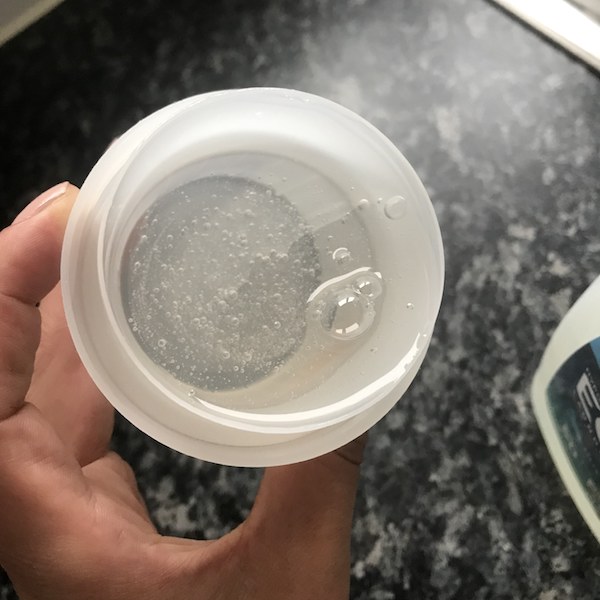
Is ECOS laundry detergent reliable for cleaning clothes?
To test the reliability of my ECOS laundry detergent, I washed three different textiles with three different stains. They included:
My work shirt. It’s quite often the case that when I am driving to my job in pediatrics that I spill coffee somewhere on myself. Professional, I know. I carry a spare shirt to compensate, but I do enjoy knowing that I can remove said stains with an everyday washing cycle.
ECOS Hypoallergenic Laundry Detergent did blast away those ugly coffee stains. I interpreted the instructions ad-verbatim, including the invitation to wash at any temperature and produce excellent results. It successfully removed Guatemalan coffee from my Zara shirt, for which I am grateful.
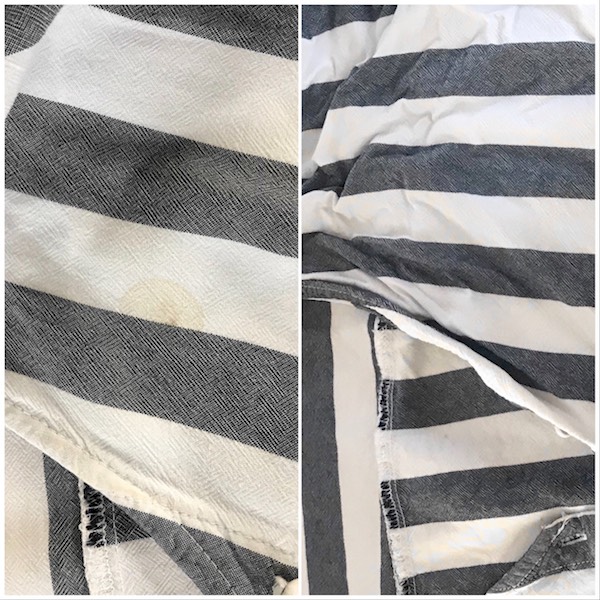
My pillowcase. The pediatrics job I mentioned? It sort of leaves me feeling so tired that I fall asleep with makeup on. Therefore, I need to know if a detergent can remove my oil-free Clinique Superbalanced Makeup.
I’m not sure whether Clinique’s Superbalanced Makeup is particularly difficult to tackle. Or, maybe it’s the fact that I rubbed it into a white cotton pillowcase while sleeping? Either way, ECOS Hypoallergenic Laundry Detergent didn’t have any effect. In the interest of remaining fair, removing stains from white cotton is difficult. But, if you bring a product to market, it should remain fit for purpose.
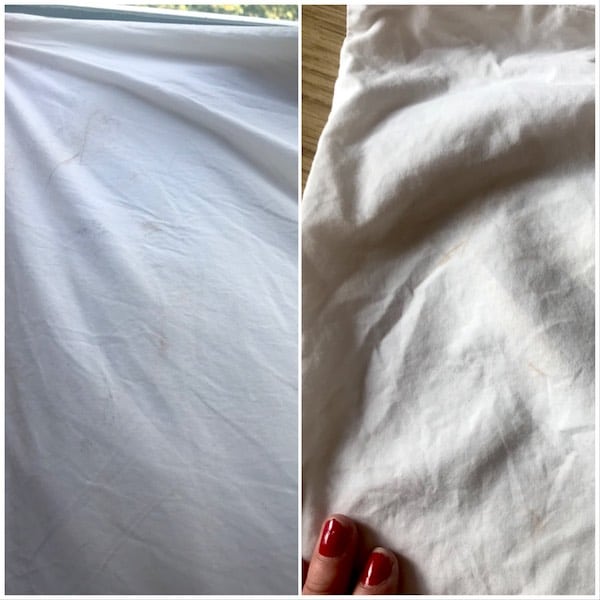
My daughter’s bathroom towel. She frequently helps herself to a Bourjois Anti-Fatigue Concealer that I no longer use, before proceeding to wipe her face on a towel.
It did blast away the ugly orange stain that my daughter imprinted on the towel. However, said towel wasn’t exactly fluffy afterward. Granted, we haven’t experienced any adverse skin reactions since using it. But, it does feel rough, which leaves me feeling as though the softener ECOS incorporates is less than adequate.
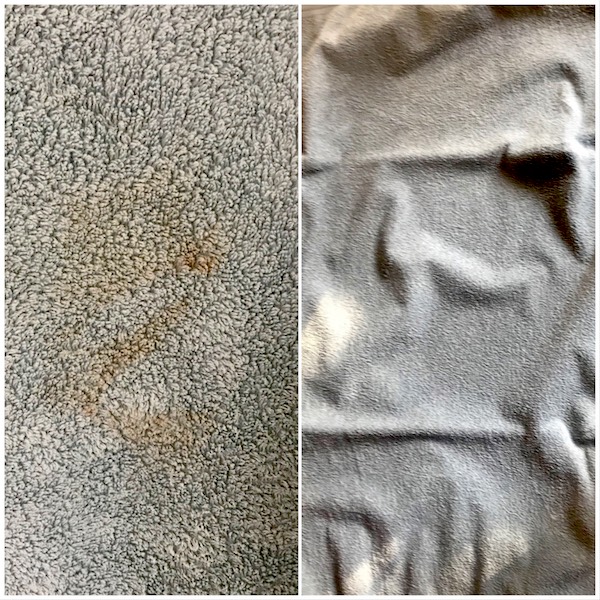
As you can see from the before pictures, all of the stains are fairly innocuous. I’ve picked my target textiles carefully to ensure they all encountered the stains within the same 24-hour period.
How is the ECOS Laundry Detergent formulated?
Now that I’ve demonstrated what the detergent can do in my household, it’s time to check out the ingredients.
Rather kindly, ECOS omit phthalates, parabens, and phosphates. Each of those ingredients has the potential to cause significant harm, even to those who don’t suffer from allergies. In particular, phthalates act as a potent carcinogen. It’s also free of ingredients thought to hormone disruptors. Or ingredients thought to cause asthma. Or ingredients likely to be contaminated with 1,4 Dioxane.
ECOS Laundry Detergent appears to draw most of its cleaning benefits from the use of plant-derived surfactants. One of these ingredients, Cocamidopropyl Betaine, is a former winner of Contact Allergen of the Year in 2004. That said, if you rinse your clothes completely it shouldn’t be too much of an issue unless you are severely allergic to it. It’s a cleaning agent used in virtually every shower gel and shampoo on the planet! Allergen aside, the manufacturers have chosen the surfactants with a great deal of care and attention. It takes real vision combined with a deep knowledge of product formulation to select these cleaning agents.
There were, however, two preservatives present that gave some cause for concern:
- Methylisothiazolinone
- Phenoxyethanol.
Although it was once universally accepted that methylisothiazolinone is a friend to those who have sensitive skin, we’ve since discovered otherwise. It was awarded Contact Allergen of the year in 2013 and responsible for an epidemic of contact dermatitis. The UK Press picked up on this and many manufacturers have since ceased using it. Unfortunately, ECOS isn’t one!
Phenoxyethanol is another ingredient that can cause contact dermatitis. It isn’t safe to ingest phenoxyethanol. Doing so increases your risk of an acute kidney injury. You should ensure ECOS Laundry Detergent isn’t within reach of children.
Would I buy ECOS Laundry Detergent again?
In a world where many of us are edging towards a greener lifestyle, it’s often difficult to find ‘the perfect’ product. While ECOS Laundry Detergent left my bath towels feeling a little stiff, it did do an excellent job at removing my self-inflicted coffee stains. Unfortunately, it did very little towards maintaining the aesthetics of my pillow cases.
Cumulatively, in terms of value for money (excellent), cleaning efficacy (so-so), and its ability to protect those with allergies (not so good), I have real mixed feelings about ECOS Laundry Detergent.
As medics who produce mountains of washing, my partner and I could always benefit from a gentler approach to our laundry. However, I would look for a more performant alternative to use on my children’s clothing.
Overall, ECOS Laundry Detergent isn’t a one-size-fits-all green laundry solution. It’ll produce great visual results with certain fabrics, but it won’t impress your guests when they’re presented with rough bath towels.
With one or two tweaks, it could be a great detergent. They need to improve its washing ability as well as replace one or two preservatives to be truly considered a great product.
But, if you want to take a small step towards achieving a greener lifestyle, feel free to road test it yourself.
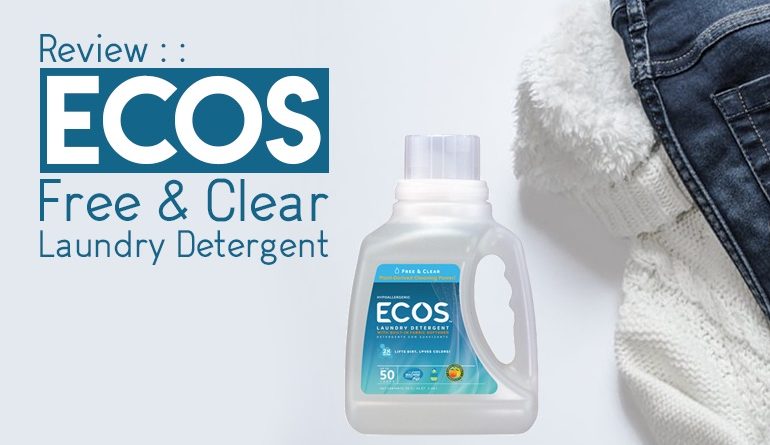
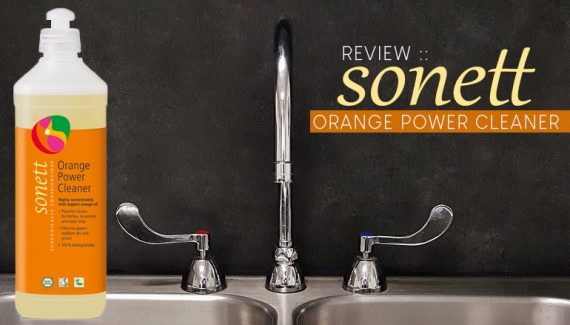
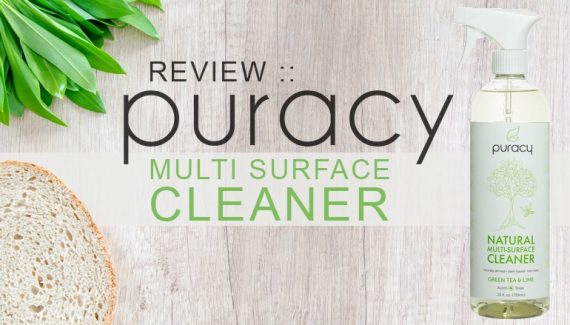
2 Comments
I just tried this detergent because it is plant based and says hypoallergenic on the bottle. I washed some brand new clothes for the first time and used this detergent. After wearing the shirt for a couple of hours, I had to take it off because it felt like my back was burning. When I took off the shirt I was covered in a bumpy rash! Will not be using this again.
I’ve been using it 2 months now it works out wonderful for me You only need to use an ounce. I have to use a softener My cross came out great